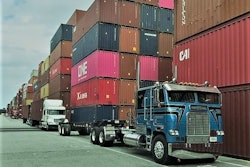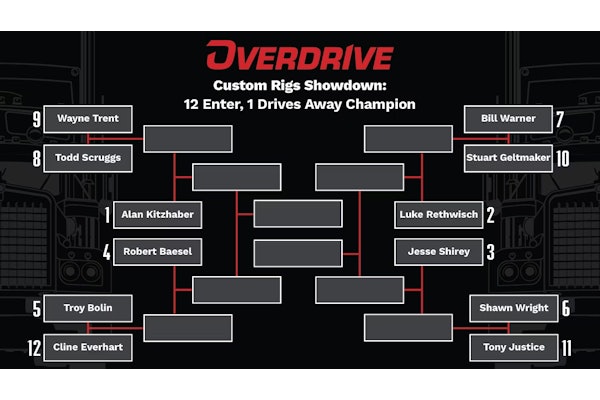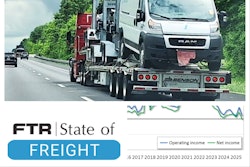I’ve written a little in past about the National Association of Small Trucking Companies’ MSP (Management and Safety Program) before, but it’s been quite a while, well before the big growth in membership NASTC has seen over the last several years, partly as a result of its fuel program. That program, the Quality Plus Network, might well be the best one going for an independent owner-operator, as per-gallon discounts at in-network truck stops can be quite substantial for members.
As an independent, getting access to the program requires membership ($250 annually), which for most is predicated on participation in one of NASTC’s New Entrant Survival Training seminars, conducted monthly at association headquarters in Gallatin, Tenn., just outside Nashville. Around the time of NASTC’s annual conference, I had the opportunity to be reacquainted with the MSP program and where it could be headed via conversations not only with NASTC President David Owen but also a couple independent owner-operators who are a part of the MSP — you might think of it as the association’s way of doing some of your back-office compliance-backstop work for you, chiefly in the area of maintaining driver-qualification files and providing the armature to defend yourself in the event of an accident.
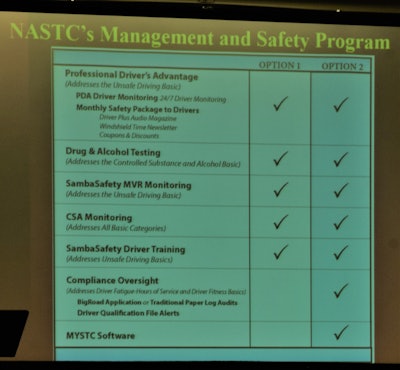 The services checked in the first column are part of the MSP at a cost of under $40 a month per truck, David Owen shared this slide at NASTC annual meeting a few weeks ago.
The services checked in the first column are part of the MSP at a cost of under $40 a month per truck, David Owen shared this slide at NASTC annual meeting a few weeks ago.The program combines Motor Vehicle Record and CSA-performance monitoring — where you’re notified directly if there’s a change to either your own record or your business’s in CSA that you may or may not have known about — with routinely delivered safety-related materials. Those materials are part of the Professional Drivers Advantage portion of the standard program.

“It’s a monthly package we send to the drivers of a company,” says Owen, and that includes to an independent owner-operator. “What is in that package is a newsletter that we write here for drivers,” which might include an interview with a multimillion-mile safe driver and various other industry news. It will include “a coupon of some value,” Owen adds, and initially a “How’s my driving?” sticker for the back of the trailer whose number goes to a NASTC call center. “The real problem solver in this package [is that it serves as a] direct monthly reminder from the owner that safety is priority No. 1. … It’s a reminder that the driver’s safety is at the front of the table.”
That’s particularly beneficial for any of you managing more than your own truck, of course, but Owen and others at NASTC also argue that for a one-truck independent one other particular benefit is shared. With the package likewise is included a 90-minute audio magazine of sorts (CD or USB at this point) that might include interviews with NASTC drivers of the year or a country music star or NASCAR driver, with a “12-20-minute safety and awareness program — expertise on backing, or driving in rough weather,” whatever the case may be, Owen says.
A piece of paper comes along with it — as driver, you sign that you’ve listened, and that goes in your driver-qualification file as “evidence that the company owner really cares,” Owen adds, evidence of routinely-conducted driver-safety meetings, something that’s often proven itself beneficial in fighting off ambulance-chasing efforts in civil litigation after a crash.
In essence, the program allows the association to help a carrier of any size “button up the business” of a fashion, and effectively demonstrate a commitment to safety should the lawyers come searching for ways to cherry-pick a further adverse conclusion to an accident in civil litigation, whoever’s fault the accident was. Given the “nuclear verdicts” we’ve seen in the large-fleet space, this could well be valuable indeed — for a small carrier, it’s at least something to arm your insurance company with as they consider fighting outsize claims.
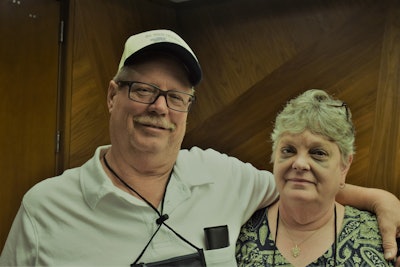 Owner-operators Daniel and Pamela Mavis
Owner-operators Daniel and Pamela MavisAmong the NASTC 2019 drivers of the year, Chippewa Falls, Wis.-based independents Daniel and Pamela Mavis have been on the MSP ($32 per driver, Daniel says) since they joined NASTC, as with so many other independents initially attracted by the fuel savings. They haul in a 2009 Peterbilt 387 and estimate that their fuel savings in the NASTC program since 2017 has more than paid for a piece of equipment they bought around that time, too, at a cost of more than $20K — a John Deere 3000 Series tractor for moving various equipment around their home base of operations.
Pamela points to utility in the MSP she’s seen particularly when auditors come calling and want to see their driver files and other records. “It’s your safety plan,” says Daniel.
NASTC has been working toward updating the media it uses for the audio magazines it sends out, allowing for USB stick delivery, and in future likely an online-delivery variant, reps say, welcome news to another independent who’s been part of the program for some time now. She likewise joined NASTC principally attracted to the fuel savings. “Their fuel program is unbeatable, it’s great,” says owner-op Debbie Desiderato. “My discounts are within 1 or 2 pennies of” many large fleets’, typically, she’s seen. “It’s pretty great to be able to get that” as an independent.
Though given her on-highway schedule, with long stretches away from her East Coast home base, she hasn’t been exactly routinely active in consuming the media associated with the MSP, she does see the same value the Mavises speak of in filing materials as routinely as possible to demonstrate an organized safety plan as a one-truck carrier. “It will probably give me a few bonus points in an audit,” she says.
Where NASTC’s possibly headed with MSP-participating carriers, too, could be particularly beneficial should they get where they want to go. As Owen put it in his presentation to NASTC members at their annual conference: “I’m a dot connector,” Owen said, adding he wants to be able to make the correlation for the 4,000-truck-strong group participating in the MSP between it “and your insurance premium, your CSA scores, [being able to be on the] A list with a shipper, being able to hire million-mile drivers knocking on your door” to get in.
If the association can square the circle as it relates to insurance premiums with the power of the group, that could well be a powerful draw, and advantage, in these challenging times for small fleets and independent owner-ops.





